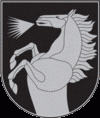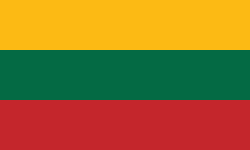Radviliškis
 |
 |
Radviliškis was founded at the end of the 15th century. It was first mentioned in the book on state economics by M. Downar-Zapolsky listing the towns taxpayers in 1567. In 1687, John Sobieski, the king of Lithuania and Poland, granted the right of holding a market to it.
Radviliškis was devastated many times by military forces, plague and hunger in the 17th–19th centuries. There were no citizens left in Radviliškis after the plague in 1708–1710.
Town growth began when the Liepāja–Romny Railway line, crossing the town, was built in 1870 and Radviliškis–Daugavpils line was built in 1873. Railwaymen constituted the majority of the residents.
Around July 12, 1941, all 300 Jews of Radviliškis were murdered in the Durpunas Forest near the Jewish cemetery by Germans and Lithuanian Activist Front members from Radviliškis.
In 1998, a sculpture of the Victory goddess Nike was unveiled in the center of Radviliškis to commemorate the eightieth anniversary of the victory over the united German–Russian West Russian Volunteer Army. It was created by sculptor P. Mazuras.
Map - Radviliškis
Map
Country - Lithuanian_Soviet_Socialist_Republic_(1918–1919)
 |
 |
| Flag of Lithuania | |
Germany had lost World War I and signed the Compiègne Armistice on 11 November 1918. Its military forces then started retreating from the former Ober Ost territories. Two days later, the government of the Soviet Russia renounced the Treaty of Brest-Litovsk, which had assured Lithuania's independence. Soviet forces then launched a westward offensive against Estonia, Latvia, Lithuania, Poland and Ukraine in an effort to spread the global proletarian revolution and replace national independence movements with Soviet republics. Their forces followed retreating German troops and reached Lithuania by the end of December 1918.
Currency / Language
| ISO | Currency | Symbol | Significant figures |
|---|---|---|---|
| EUR | Euro | € | 2 |
| ISO | Language |
|---|---|
| LT | Lithuanian language |
| PL | Polish language |
| RU | Russian language |















